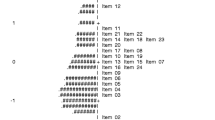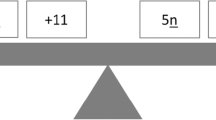Abstract
The study compared the results of three cross-sectional and large-scale group studies conducted in Cyprus, Israel, and the USA. The studies examined the acquisition of the formal schemata of control of variables, proportions, probability, correlations, and combinations during the secondary school years. Despite the differences among the three studies in terms of sampling procedures, sample sizes, tasks (content and type), and administrative procedures, the results provided evidence that the examined schemata represent singular cognitive structures showing a common developmental trend. These schemata appeared to be acquired gradually across age rather than in wholesale spurts. The wide range of student performance on the test items across all grade levels appears to be related to differences in task difficulty. The range also suggests that the development and saturation of these abilities are not completed even for twelfth-grade students, and that a high percentage of secondary school students are still in the process of developing them. There were also indications for the possible effects of differences in science and mathematics teaching as well as other educational factors on cognitive development which when identified could provide guidelines for teaching interventions conducive to facilitating students' development of their reasoning capacities.
Similar content being viewed by others
REFERENCES
Adey, P.S., & Shayer, M. (1990). Accelerating the development of formal thinking in middle and high school students. Journal of Research in Science Teaching, 27, 267-285.
Adey, P.S., & Shayer, M. (1994). Really raising standards: Cognitive intervention and academic achievement. London: Routledge.
Ahlawat, S.K., & Billeh, V.Y. (1987). Comparative investigation of the psychometric properties of three tests of logical thinking. Journal of Research in Science Teaching, 24, 93-105.
Buck-Morss, S. (1975). Socioeconomic bias in Piaget's theory and its implications for cross-cultural studies. Human Development, 18, 35-49.
Byrne, R.M.J. (1989). Suppressing valid inferences with conditionals. Cognition, 31, 61-83.
Cheng, P., & Holyoak, K. (1985). Pragmatic reasoning schemas. Cognitive Psychology, 17, 391-416.
Dasen, P.R., & Heron, A. (1981). Cross-cultural tests of Piaget's theory. In H.C. Triandis & A Heron (Eds.), Handbook of cross-cultural psychology. Vol. 4. Developmental psychology (pp. 295-342). Boston, MA: Allyn & Bacon.
Eckstein, S.G., & Shemesh, M. (1992). The rate of acquisition of formal operational schemata in adolescence: A secondary analysis. Journal of Research in Science Teaching, 29, 441-451.
Flavell, J.W., & Wohlwill, J.F. (1969). Formal and cognitive aspects of cognitive development. In D. Elkind & J.H. Flavell (Eds.), Studies in cognitive development (pp. 67-120). New York: Oxford University Press.
Greenfield, P.M. (1976). Cross-cultural research and Piagetian theory: Paradox and progress. In K. Riegel & J. Meacham (Eds.), The developing individual in a changing world (Vol. 1, pp. 225-226). The Hague: Mouton.
Griggs, R.A., & Cox, J.R. (1982). The elusive thematic materials' effect in Watson's selection task. British Journal of Psychology, 73, 407-420.
Inhelder, B., & Piaget, J. (1958). The growth of logical thinking from childhood to adolescence. New York: Basic Books.
Inhelder, B., & Piaget, J. (1964). The early growth of logic in the child. New York: Norton.
Johnson-Laird, P.N. (1983). Mental models. Cambridge, MA: Harvard University Press.
Karplus, R., Adi, H., & Lawson, A. (1980). Intellectual development beyond elementary school VIII: Proportional, probabilistic, and correlational reasoning. School Science and Mathematics, 8, 673-683.
Keats, D.M. (1985). Strategies in formal operational thinking: Malaysia and Australia. In I. Reyes Lagunes & Y.H. Poortinga (Eds.), From a different perspective: Studies of behavior across cultures (pp. 306-318). Lisse: Swets & Zeitlinger.
Kelly, M.R. (1977). Papua New Guinea and Piaget-An eight-year study. In P.R. Dasen (Ed.), Piagetian psychology: Cross-cultural contributions (pp. 169-202). New York: Gardner/Wiley.
Kuhn, D., & Brannock, J. (1977). An experimental study of the development of formal operational thought. Child Development, 47, 667-706.
Laurendeau-Bendavid, M. (1977). Culture, schooling, and cognitive development: A comparative study of children in French Canada and Rwanda. In P.R. Dasen (Ed.), Piagetian psychology: Cross-cultural contributions (pp. 123-168). New York: Gardener/ Wiley.
Lawson, A.E. (1978). The development and validation of a classroom test of formal reasoning. Journal of Research in Science Teaching, 15, 11-24.
Lawson, A.E., Karplus, R., & Adi, H. (1978). The acquisition of propositional logic and formal operational schemata during the secondary school years. Journal of Research in Science Teaching, 15, 465-478.
Linn, M.C. (1981). Correlates of formal reasoning: Content and problem effects. Journal of Research in Science Teaching, 18, 435-447.
McKenzie, D., & Padilla, A. (1982). Are proportional and probabilistic reasoning prerequisites to correlational reasoning? Paper presented at the annual meeting of the National Association for Research in Science Teaching, Fontana, WI.
Mishra, R. (1997). Cognition and cognitive development. In J.W. Berry, P.R. Dasen, & T.S. Saraswathi (Eds.), Handbook of cross-cultural psychology (2nd ed.). Vol. 2. Basic processes and human development (pp. 143-175). Boston, MA: Allyn & Bacon.
Neimark, E. (1979). Current status of formal operational research. Human Development, 22, 60-67.
Pascual-Leone, J. (1972). A neo-Piagetian interpretation of conservation and the problem of horizontal decalage. Paper presented at the Canadian Psychological Association Meeting, Montreal.
Pascual-Leone, J. (1988). Organismic processes for neo-Piagetian theories: A dialectical causal account of cognitive development. In A. Demetriou (Ed.), The neo-Piagetian theories of cognitive development: Toward an integration (pp. 25-64). Amsterdam: North-Holland.
Philip, H., & Kelly, M.R. (1974). Process and product in cognitive development. British Journal of Educational Psychology, 44, 248-265.
Piaget, J. (1972). Judgment and reasoning in the child. Littlefield, NJ: Adams.
Preiswerk, R. (1976). Jean Piaget et les relations inter-culturelles. Revue Européenne des Sciences Sociales, 14, 495-511.
Prosser, M. (1983). Relationship between the cognitive abilities of a group of tertiary physics students and the cognitive requirements of their textbooks. Science Education, 67 (1), 75-83.
Renner, J.W., Stafford, D.G., Lawson, A.E., McKinnon, J.W., Frior, F.E., & Kellogg, D.H. (1976). Research, teaching and learning with the Piagetian model. Norman, OK: University of Oklahoma Press.
Saxé, G.B. (1981). Body parts as numerals: A developmental analysis of numeration among remote Oksapmin village populations in Papua New Guinea. Child Development, 52, 306-316.
Shayer, M., Kucherman, D.E., & Wylam, H. (1976). The distribution of Piagetian stages of thinking in British middle and secondary school children. British Journal of Educational Psychology, 46, 164-173.
Shea, J.D. (1985). Studies of cognitive development in Papua New Guinea. International Journal of Psychology, 20, 33-61
Shemesh, M., Eckstein, S.F., & Lazarowitz, R. (1992). An experimental study of the development of formal reasoning among secondary school students. School Science and Mathematics, 92, 26-30.
Tapé, G. (1994). L'intelligence en Afrique: Une étude du raisonnement expérimental. Paris: L'Harmattan.
Tobin, K., & Capie, W. (1980). The development and validation of a group test of logical thinking. Paper presented at the annual meeting of the American Educational Research Association, Boston.
Tobin, K., & Capie, W. (1981). The development and validation of a group test of logical thinking. Educational and Psychological Measurement, 41, 413-423.
Valanides, N. (1990). Pragmatic versus syntactic approaches to deductive reasoning. Doctoral dissertation, State University of New York at Albany. Dissertation Abstracts International, 51, 1175A. (University Microfilms No. 90-24947).
Valanides, N. (1995). Investigation of the cognitive development of seventh-to twelfthgrade students. Psychology: The Journal of the Hellenic Psychological Society, 2, 165-193.
Valanides, N. (1996). Formal reasoning abilities and science teaching. School Science and Mathematics, 96 (2), 99-107.
Valanides, N. (1997a). Formal reasoning abilities and school achievement. Studies in Educational Evaluation, 23 (2), 169-185.
Valanides, N. (1997b). Cognitive abilities among twelfth-grade students: Implications for science teaching. Educational Research and Evaluation, 3 (2), 160-186.
Valanides, N. (1998). Formal operational performance and achievement of lower secondary school students. Studies in Educational Evaluation, 24 (1), 1-23.
Valanides, N. (in press). Formal operational performance of higher secondary school students: Theoretical and educational implications. The European Journal of the Psychology of Education.
van de Vijver, F.J.R., & Leung, K. (1997). Methods and data analysis for cross-cultural research. London: Sage.
Vuyk, R. (1981). Overview and critic of Piaget's genetic epistemology 1965-1980. New York: Academic Press.
Wason, P.C. (1983). Realism and rationality in the selection task. In J. St. B.T. Evans (Ed.), Thinking and reasoning (pp. 44-79). Boston, MA: Routledge & Kegan Paul.
Author information
Authors and Affiliations
Rights and permissions
About this article
Cite this article
Valanides, N., Markoulis, D. The Acquisition of Formal Operational Schemata During Adolescence:A Cross-National Comparison. International Journal of Group Tensions 29, 135–162 (2000). https://doi.org/10.1023/A:1005182814532
Issue Date:
DOI: https://doi.org/10.1023/A:1005182814532




